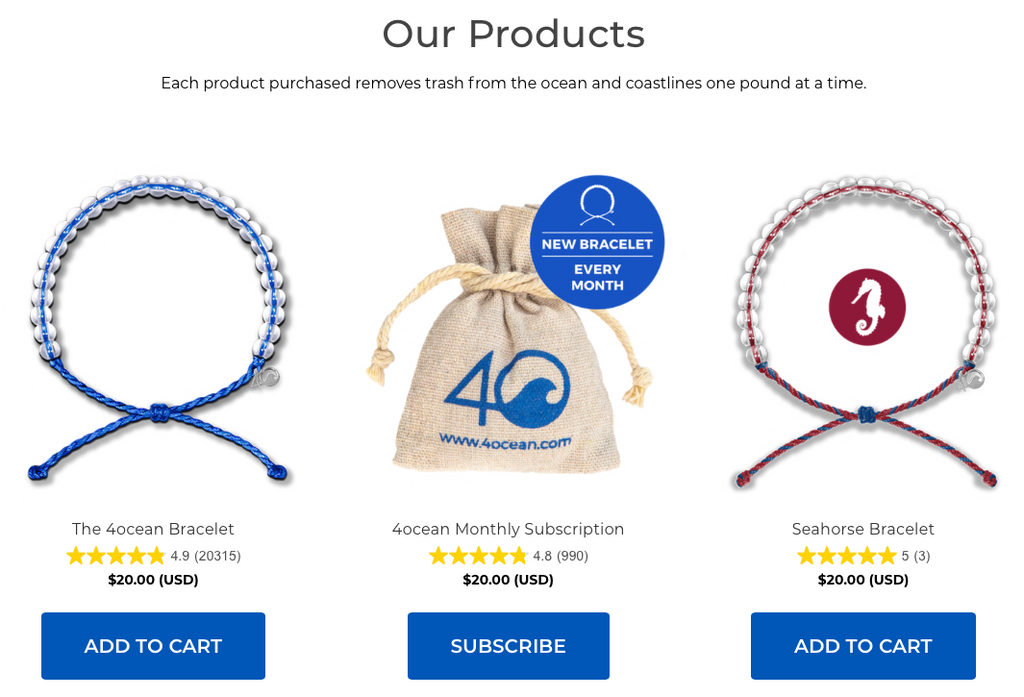At 4ocean, we are in love with the Great Barrier Reef!
As a UNESCO World Heritage Site and one of the Seven Natural Wonders of the World, the majesty, diversity and pure fascination of the Great Barrier Reef (the "Reef") are unparalleled anywhere in the marine world. It hosts more than 1,625 species of fish (about 10% of the entire world's known fish species), over 600 types of hard and soft corals, 30 species of whales and dolphins, 215 types of birds, and 6 of the world's 7 sea turtle species, truly making it the "rainforest of the sea."

But this incredibly complex and biodiverse ecosystem is under serious threat on many fronts and immediate action is necessary to save this natural treasure for future generations. Our non-profit partner for the month, Great Barrier Reef Foundation, is bringing together the best minds and technologies from around the world to help solve some of the biggest challenges facing the Reef. Things like ocean plastic pollution, rising ocean temperatures, ocean acidification, an increase in the frequency of severe weather events, poor water quality/pollution, and the out of control growth of some native species are all wreaking havoc on the fragile Reef. But, the good news is that coral reefs are naturally resilient. Everyone's actions, whether big or small, to reduce threats and restore conditions will improve the Reef's outlook.
That is where the Great Barrier Reef Foundation comes in, and they are making some significant strides in the effort to drive the science of the Reef forward. They have been involved in bringing some amazing, cutting-edge projects to fruition since their inception in 1999. Here is just a short list of some of them.
Larval "Reseeding": In Vitro Fertilization for Corals
Larval "reseeding" is a technique scientists are using to restore small areas of damaged reef. The tiny coral spawn are collected during the Reef's annual mass spawning event and carefully raised into healthy "baby" corals. Then they're placed over small sections of the Reef in underwater mesh tents where some of them are able to take hold. After only eight months, 100 surviving juvenile corals had established themselves in the test reef area. This holds some amazing promise and now the need is to scale this up to a much larger size. You can check out a video from local news media about the process here.
LarvalBot: The Robo Reef Generator
Taking the concept of larval "reseeding" a step further, this project springs into action during the mass coral spawning period that occurs on the Reef in November. Scientists will collect hundreds of millions of coral spawn and rear them into "baby" corals inside large floating enclosures out in the ocean. The robotic technology, LarvalBot, as it is fondly referred to, will then become the proverbial "stork" of the Reef, delivering these tiny coral larvae back to areas that need coral restoration. The plan is to greatly increase the scale of this method to take advantage of the annual spawning event all over the Reef.
 Graphic: Great Barrier Reef Foundation
Graphic: Great Barrier Reef Foundation
![]() Photo: Great Barrier Reef Foundation/Biopixel
Photo: Great Barrier Reef Foundation/Biopixel
RangerBot: The Robo Reef Protector
Dubbed the "Swiss Army Knife" of the Reef, RangerBot is a multi-tasking, multi-purpose autonomous underwater robot that has the potential to enhance the way the Reef is managed. With its capability to cover an incredible amount of water compared to a human diver and ability to monitor Reef indicators like coral bleaching and water quality, as well as its machine learning skills to literally kill outbreaks of coral-destroying species like the crown of thorns starfish when needed, RangerBot could be the wave of the future.
Graphic: Great Barrier Reef Foundation
Reef Islands Initiative
The Great Barrier Reef is much more than a cluster of coral reefs along a coastline. As a matter of fact, the reefs themselves make up only about 7% of the entire protected area. There is an astonishing variety of other marine habitats including seagrass beds, mangrove estuaries, and more than 1,000 islands that also share the sanctuary of the Great Barrier Reef Marine Park. Reef islands and their nearby reef habitats play an important role in protecting the thousands of species that call these areas home, both above and below the water. Lady Elliot Island is the first new climate change "ark" included in the Reef Islands Initiative.
As you can see, the Great Barrier Reef Foundation is heavily invested in the health and vitality of the Reef and we couldn't be happier they are our partner for the Great Barrier Reef Bracelet. Obviously, there is much more work to be done, but the solutions they are helping to pioneer may just hold the key to ensuring the wonder of the Reef is around for future generations. Not only are the tools and techniques being tested here viable in this location, but they could also be used on reef systems all around the world that are experiencing many of the same symptoms of decline. If you want to donate to their incredible work directly you can do so here.
Have you ever been to the Great Barrier Reef? If so, share your story in the comment section below, we would love to hear about it. Also, head on over to our Discover 4ocean Facebook Group and make sure to follow us on Facebook, Instagram, and Twitter to stay up to date on all things 4ocean!






